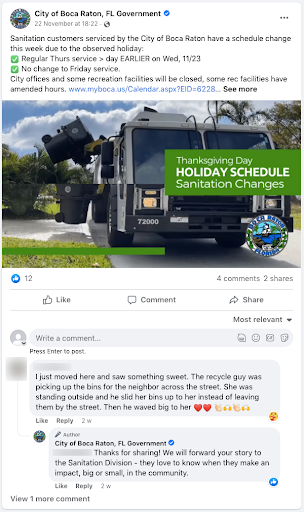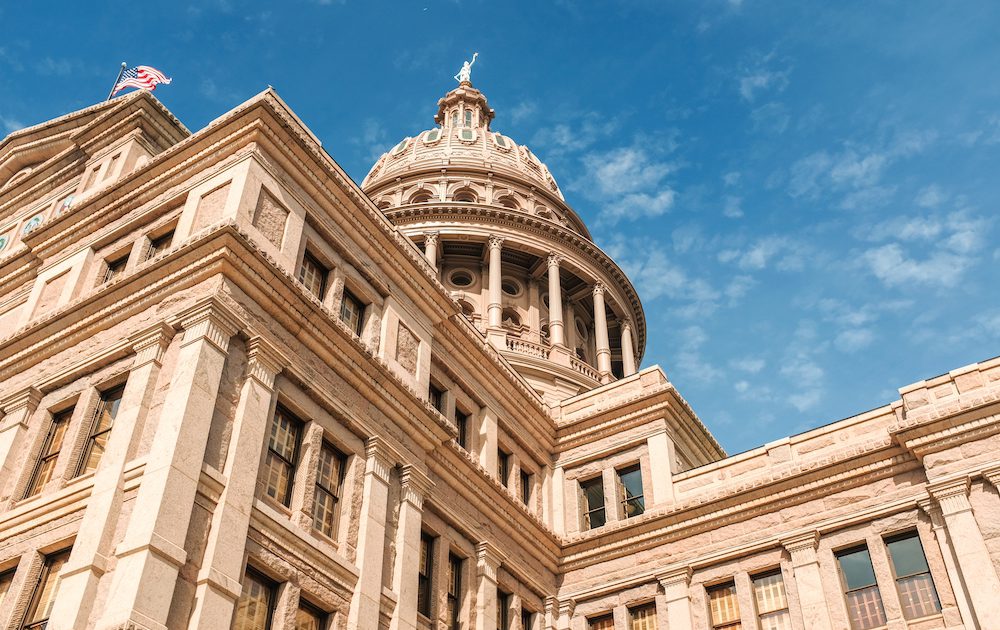Social media for government agencies is about demonstrating your expertise, building trust and credibility, and providing audiences with fast, reliable, unambiguous information. It’s been a game-changer for the sector, transforming previously faceless organizations into teams of real people doing valuable work.
Lots of agencies are doing an amazing job at showcasing what they do (and how they do it), helping them build large, highly engaged audiences.
But getting it right can be tough. Every government social media marketer occasionally struggles with ideas or a lack of content. With that in mind, we’ve rounded up ten tips and strategies to boost engagement for government on social media.
Provide Community News & Updates
Arguably the most obvious use case of social media for government agencies is providing news and relevant updates to your community.
Whether an important public service announcement, a local road closure, or an inspiring success story, news-driven content should be one of the key components of your social media content strategy. It helps position your agency as a source of authority, which builds trust in your brand and improves your public perception.
Here’s a perfect example from the City of Phoenix:
The City of #Phoenix is excited to receive a $1 million grant from @FTA_DOT to help w/ the South-Central / Downtown Hub light rail extension.
Read more about this funding and the overall Transportation 2050 plan in the #PHXNewsroom: https://t.co/t7zQxXcIdM@PhoenixMetroBus#PHX pic.twitter.com/xForZlIIwb
— City of Phoenix, AZ (@CityofPhoenixAZ) December 9, 2022
This post communicates positive news for the city and provides a call to action for readers interested in learning more.
Most of all, it demonstrates that news-based posts don’t need to be especially complicated or creative. When it comes to reporting breaking news, keep it simple.
Showcase Real People At Your Agency
Building trust and boosting public perception is a key goal of social media for government agencies.
One of the best ways to achieve it is to humanize your social media marketing by showcasing some of the real people working at your agency. After all, it’s far easier for your audience to trust a human than a faceless organization.
The Department of Energy clearly understands this. It regularly shares information about the work carried out by its employees, such as this example:
Not only is this a consistent source of content, but it’s also a highly effective way to engage your community, show your human side, and increase engagement.
Treat Social Media As a Two-Way Conversation
At its best, social media acts like a public forum: a place for conversation (and sometimes debate) between interested parties. Of course, conversations must be a two-way process.
Your followers can use your social media pages to report concerns, react to news, or simply to share whatever’s on their minds. But it’s not just about what they post; it’s about how you respond.
You might receive dozens or hundreds of comments a day. No doubt, responding to them sounds like a lot of work. But the fact is, a large chunk of your audience expects you to reply. According to research from Jungle Scout, 46% of consumers believe it’s essential for brands to respond to social media comments.
The City of Boca Raton demonstrates the benefits of responding to comments:

This is a nice comment. If the city had simply ignored it, there’s little incentive for the follower to further engage with the City of Boca Raton’s social media content. If someone takes the time to get in touch, you should try your best to get back to them.
Share Public Service Information
Government agencies are a public service. Using your social media profiles makes sense to share valuable news and information with your audience.
Of course, we’ve seen this type of activity throughout the pandemic. But there are many other reasons you might need to reach out to your followers with essential advice.
For instance, the Iowa Department of Natural Resources provided this invaluable update about what motorists should do if a deer runs out in front of them:
View this post on Instagram
As you can see, this post isn’t just a simple image and some written advice; they accompany it with a dedicated graphic that breaks down the information. This style doesn’t just make the post easier to understand — it also makes it more shareable.
Don’t Shy Away From Humor
Government agencies do serious work, making breathing humor into your social media content challenging.
Naturally, there will be many times when it isn’t appropriate to say something funny. Often, your best bet is simply to play it straight. But that doesn’t mean there’s no room for humor.
It’s important to remember that “funny” content isn’t something frivolous you can post between more important information. It delivers actual results, with research suggesting that audiences are more inclined to see us as confident and competent at our jobs when we use humor appropriately. So it should form a part of any strategy for government on social media.
The Transportation Security Administration is one agency that’s nailed its use of humor. They pack their Instagram full of (terrible) puns, but that doesn’t stop the agency from communicating important information — such as in this post about traveling with knitting needles:
View this post on Instagram
Dig Into the Vaults
It stands to reason that the people who follow your social media accounts are interested in what you do.
Many government agencies have driven a ton of engagement by sharing images and information about their histories and communities. This strategy is a guaranteed win for local agencies: find old pictures of your location with a story behind them and share them. It will likely lead to engagement.
But what if you’re a federal agency with no specific geography?
The Consumer Product Safety Commission proves there’s still an opportunity to benefit from promoting historical content. In one example, the agency opened up its archive of old public service announcements (PSAs) and shared them in a Twitter thread:
In 2019, we found out some of our oldest PSAs, many unseen for decades, would not be saved permanently in the National Archives. We had a choice – save them or send them to a lonely landfill somewhere.
We saved them all.
Now, we’re publishing them online for the first time. ? pic.twitter.com/XSAgdmEvj8
— US Consumer Product Safety Commission (@USCPSC) November 28, 2022
Its efforts generated lots of engagements, with followers weighing in on everything from the actors in the videos to memories of their favorite PSAs.
Use Community & Event-Specific Hashtags
Hashtags are an invaluable way to stay on top of social media conversations — particularly for agencies with huge followings.
Twinning your posts with an accompanying hashtag doesn’t just make your content more visible, but it also makes it easier for your team to manage responses (and respond themselves).
For instance, the Michigan Department of Natural Resources regularly shares posts with the hashtag #IdentiFriday, encouraging its followers to identify some of the state’s best-loved and lesser-known species:
But this strategy isn’t just about creating hashtags and adding them to posts. It’s also about monitoring popular hashtags within your location or community to ensure you don’t miss important news and are well-placed to join relevant conversations.
Create Platform-Specific Content
It inevitably takes more time to create dedicated content for each social media account than simply sharing identical posts across multiple social channels.
Unfortunately, there are few shortcuts in social media for government agencies. If you genuinely want to boost engagement, your best bet is to invest time and resources in crafting platform-specific messaging.
That means analyzing each platform to understand the types of content that work best on each.
The US Postal Service shows us how this looks in practice:
Me, an empath, knowing everyone wants a handwritten letter ??
— U.S. Postal Service (@USPS) October 27, 2022
This post is perfect for Twitter, using the type of phrasing popular on the platform. But a simple, 60-character post without accompanying media wouldn’t work on any other social media site.
Celebrate Awareness Days (Provided You Have Something to Say)
There’s no shortage of awareness days. If you were short on content ideas, you could probably come up with a different awareness event-themed post for every day of the year. However, when it comes to driving engagement, there are good and wrong ways to get involved in these occasions.
The wrong way is to latch onto any old awareness day and share a throwaway post about it. “Happy National Clean Your Desk Day, everyone!”
On the other hand, the National Science Foundation shows us how to get it right:
First, it’s picked a meaningful event relevant to its audience (and employees). Secondly, and most importantly, it has something to say about the occasion. If you can’t put your unique spin on an awareness day, it’s not worth posting.
Tell a Story
Storytelling can be one of the most valuable tools for marketers in any industry, and the world of social media for government is no different. According to Google and Talk Shoppe research, 94% of consumers agree that good content tells a story, while 92% believe it should be created with thought and effort.
So what does effective storytelling look like for government agencies? Here’s a fantastic example from the US Fish and Wildlife Service:
View this post on Instagram
This content could easily have been a simple, visual Instagram post with a short caption saying, “This is Wisdom, the oldest bird in the world!” That’d still be interesting and pretty shareable.
But the agency took things (several steps) further by telling Wisdom’s story, from the moment they first identified her to the name of her long-term partner, Akeakamai.
Social media is often about sharp, punchy content. But if you have an exciting story to tell, don’t be afraid to go in-depth — it’ll make for a more engaging post.
Featured Image by wirestock on Freepik.
Are you interested in more content like this? Sign up for our next government social media conference and learn how to boost your social media engagement.
Here are some similar articles you might enjoy:
- 5 Tips for Government Agencies to Create Their Best LinkedIn Page
- 6 Things to Know About Building Your Brand Voice as a Government Agency
- How Government Agencies Can Consistently Create Great Content










